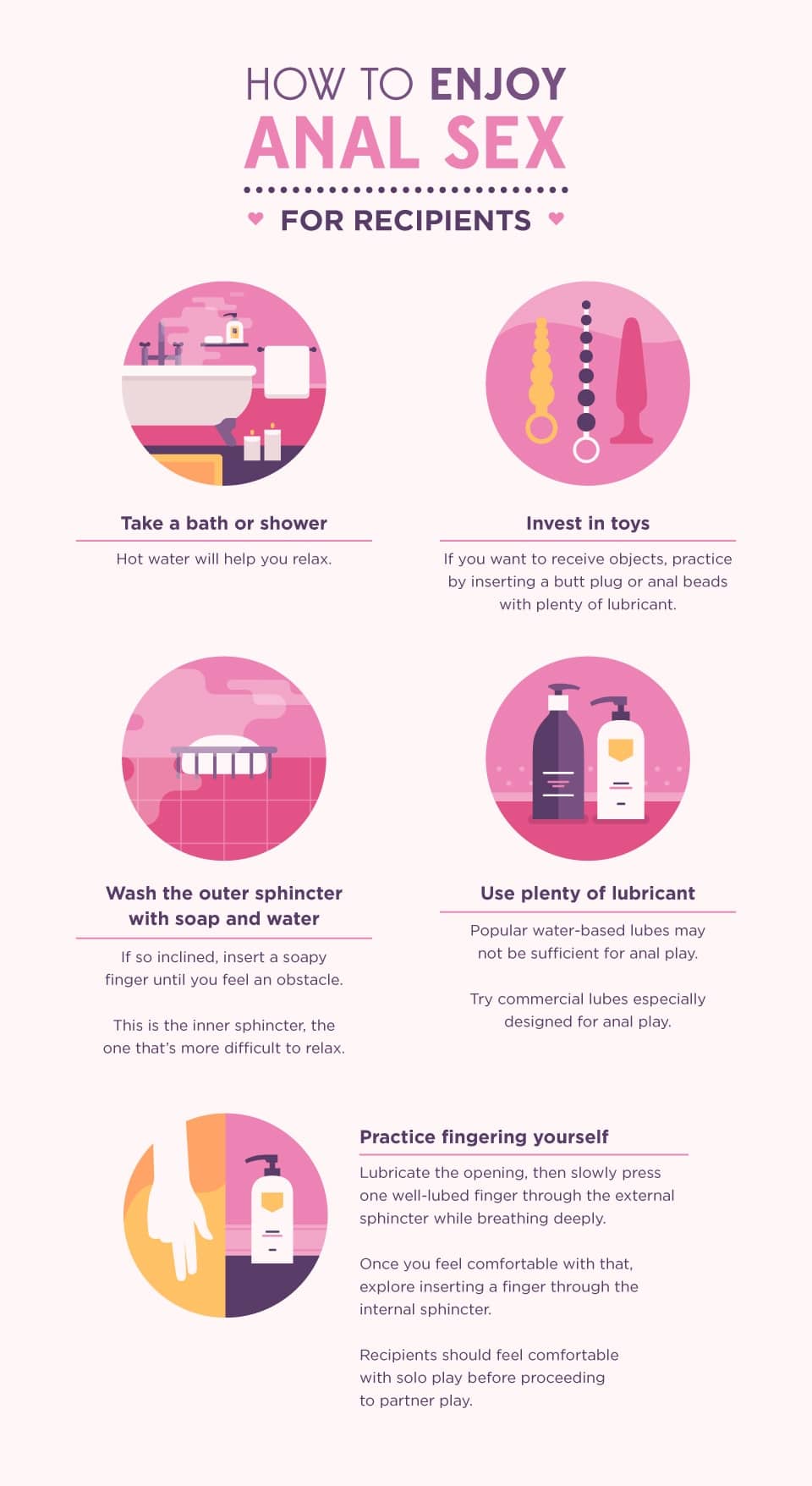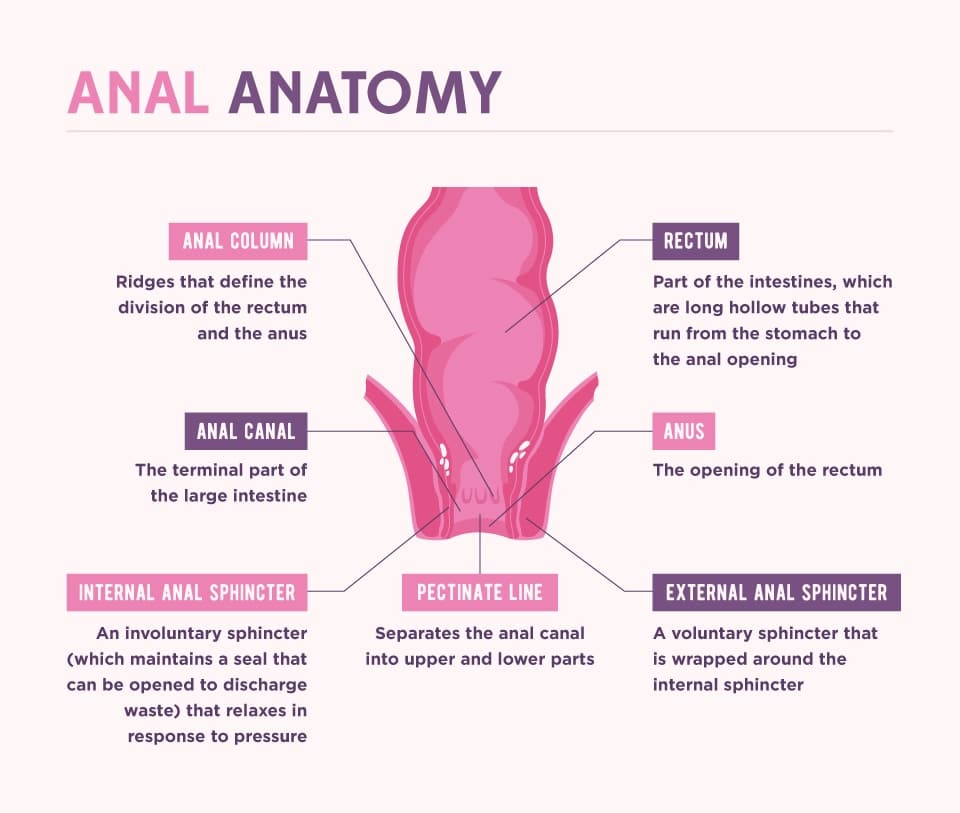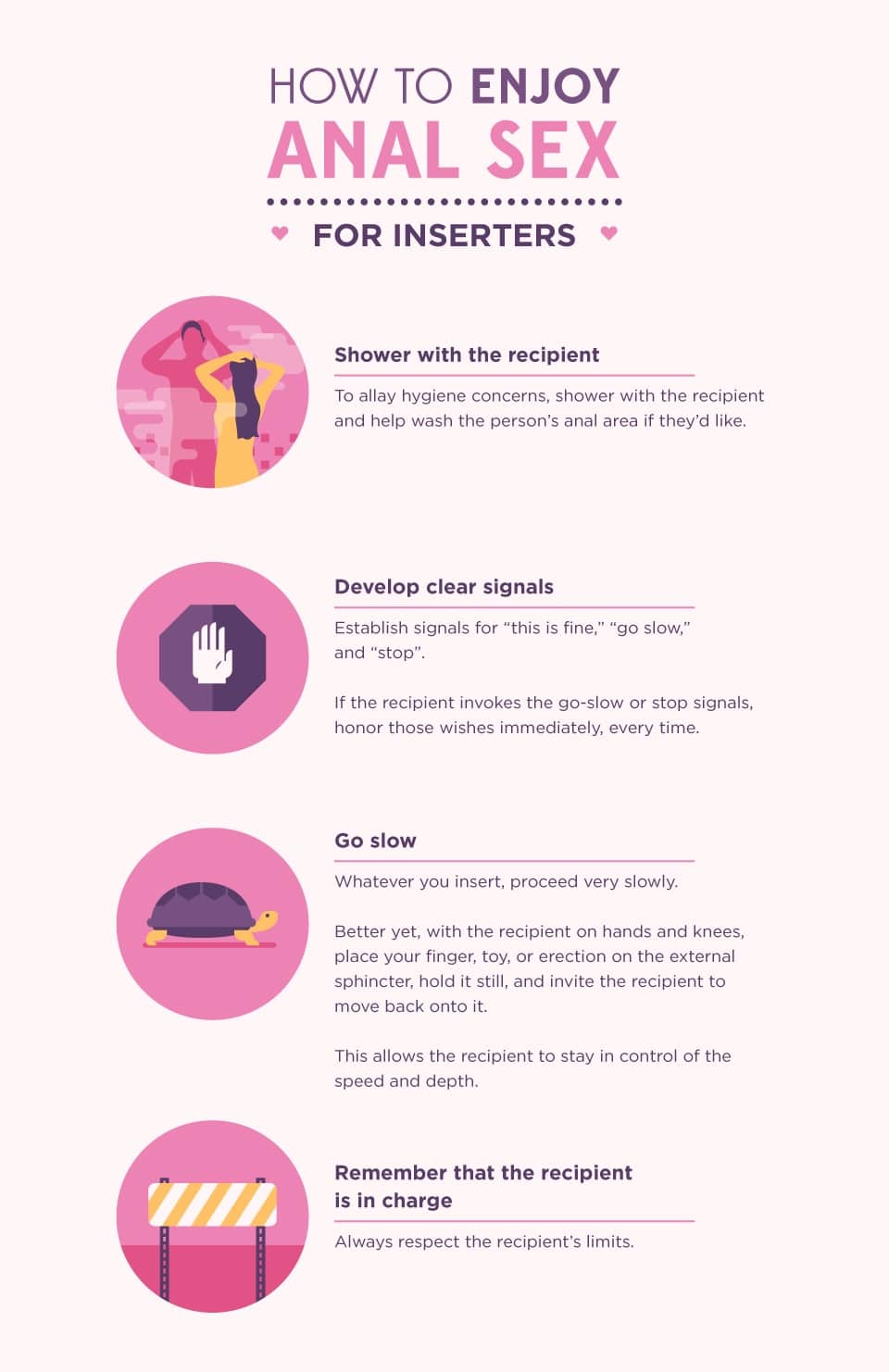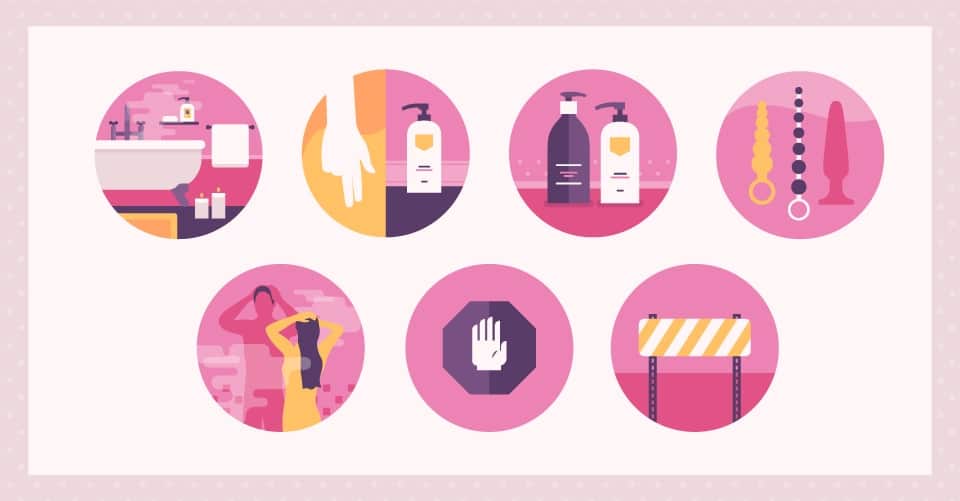Many people are uncomfortable with the idea of anal sex. And with age, anal sex may seem even more taboo. But if you’re curious about lovemaking a derriere—no matter how old you or your partner are—or hope to reduce any discomfort or pain you experienced or caused during previous anal sex experiences, this primer should help. Let’s break down some myths and truths about anal sex.
Myth: Anal sex is dirty and disgusting.
Truth: That’s how our culture views the anus; if you strongly agree, anal play is not for you. The key to happy anal exploration is cleanliness. It’s important to bathe or shower beforehand and wash the area thoroughly. Some people also rinse internally with enemas or anal douches, which are available at pharmacies. When well washed, the sphincter and surrounding skin are as clean as any other part of the body, and anal play—including oral-anal “rimming”—is hygienic and safe.
However, some stray digestive-tract bacteria may remain inside the anus. That’s why nothing that goes in there should come into contact with the vagina. Anal bacteria may travel up the urethra and cause a urinary tract infection.
Myth: Anal sex is perverted. No normal person could enjoy it.
Truth: Actually, many normal, healthy people of all shapes, sizes, and ages find it pleasurable. Similar to the genitals, the anus is richly endowed with touch-sensitive nerves. Gentle sphincter massage or finger insertion triggers these nerves and can provide pleasure. In addition, the pelvic floor muscles, which contract during orgasm, form a figure-eight around the genitals and anus. Both genital and anal play stimulate these muscles, often adding to the pleasure of orgasm.
Myth: Anal sex hurts the recipient.
Truth: Anal play should never hurt (except possibly in the context of consensual BDSM relationships). Unfortunately, anal play often causes pain—one of the main reasons people stop doing it.
Why the pain? Usually, inserters are poorly informed about the fine points of anal sex and push forcefully when the recipient is ill-prepared to receive whatever is entering: a finger, erection, sex toy, or another object. But with a little information, adequate preparation, and total agreement that the recipient is always in control of the speed and depth of insertion, anal play can be pain-free, erotically satisfying, and intimate.
Intimacy involves self-revelation, disclosing to a special companion who you really are. When partners negotiate and share an interest in anything sexually out of the ordinary, such as anal play, those conversations are mutually revelatory and enhance intimacy.

Myth: Anal sex is only for gay men.
Truth: Gay men laugh, hold hands, kiss, and engage in oral sex. Are laughing, hand-holding, kissing, and oral limited to gay people? Of course not. The same goes for anal sex. Sexual orientation has nothing to do with what you do. It’s all about who you prefer to do it with.
Myth: Anal sex equals penis-anus intercourse.
Truth: Penis-anus intercourse is the least popular form of anal play. Most lovers limit it to sphincter massage, rimming, or gentle, shallow fingering.
Myth: Everyone is trying anal.
Truth: Fantasies of anal play are quite popular; that’s why porn often depicts it. But porn is often fantasy. In real life, many couples try anal play but only a minority engage in it regularly.
In the “Sex in America” survey, University of Chicago researchers interviewed a representative sample of 3,432 U.S. adults aged 18 to 59. While the survey is more than two decades old, it is still the most widely cited study of its kind. Findings include:
- Those who’d tried anal play at least once: 25 percent.
- Those who’d played that way during the year before being interviewed: 9 percent.
- Those who’d engaged in anal the last time they made love: 2 percent of the men, 1 percent of the women.
A larger, broader, and more recent survey by University of Indiana researchers interviewed 5,865 people between the ages of 14 and 94. It found people were engaging in somewhat more anal play than before. Compared with people born before 1980, research shows younger adults are more likely to engage in anal play.
Myth: The anus is what you see down there.
Truth: Actually, much of the anal area isn’t visible to the naked eye. The anus contains not one, but two sphincters surrounded by rings of muscle; one is obvious while the other is hidden about an inch inside the opening. The external sphincter is easier to relax. If anal play causes pain, the usual cause is a clenched inner sphincter.
Inside the internal sphincter, the narrow anal canal extends an inch or two to the rectum, which is a wider, five-inch cylinder with curves that vary from person to person. Anything inserted into the rectum must negotiate these curves, which is why the anal insertion of any object should proceed very slowly, with lots of lubrication. And as mentioned before, the recipient should always remain in control of the speed and depth of insertion.
Usually, the rectum and anal canal contain only traces of stool. Most fecal material is stored just above the rectum, but anything that goes deep into the anus may make contact.

Myth: Anal insertion is just like vaginal or oral sex, except the opening is smaller and tighter.
Truth: There’s a huge difference between the anus and other erotic openings. Unlike the vagina and mouth, the anus and rectum are not self-lubricating. For vaginal intercourse, added lubrication is optional based on how much the woman naturally produces. But for safe and pain-free anal play, you must use plenty of lubricant every time. Sexual lubricants are available over-the-counter in pharmacies and grocery stores, usually adjacent to the condoms.
Myth: Anal sex causes hemorrhoids.
Truth: No, it doesn’t. Hemorrhoids are caused by a combination of constipation and hard stools. Hemorrhoids are varicose veins that develop around or inside the anus. Various veins drain blood from the anal area and then expand during defecation and shrink back to normal size afterward. Repeated straining during defecation from constipation and/or hard stools, however, can interfere with this process and keep the veins permanently swollen. Swelling, which weakens anal blood vessels, triggers nearby nerves, which cause pain. Defecation can rupture them and lead to bleeding. Risk factors include anything that places pressure on anal-area veins, notably straining when defecating, pregnancy, and obesity.
Both constipation and hard stools are caused by a low-fiber diet that lacks sufficient fruit and vegetables. If you have hemorrhoids, anal play can trigger pain and/or bleeding, but anal sex does not cause hemorrhoids. Minor bleeding (pink streaks on toilet paper) is no cause for alarm. If you notice more bleeding, call your doctor immediately.
Myth: Anal sex permanently stretches the anus, leading to stained underwear.
Truth: The anal sphincters open and close regularly throughout life. Assuming that yours close normally after defecation, they’ll do the same after anal play.
Myth: Anal sex cannot spread sexually transmitted infections (STIs).
Truth: Anal sex can transmit several STIs including gonorrhea, genital warts, and HIV. If you have penis-anus intercourse and are not 100 percent certain your partner is STI-free, use condoms every time.
Myth: You can get pregnant from anal sex.
Truth: Very little anal play involves ejaculation into the anal canal. And even when it does, sperm in the anus have no access to the uterus and fallopian tubes, so there is no pregnancy risk with anal play.
How To Enjoy Anal Play: For Both Recipients and Inserters
Anal play is most enjoyable in the context of deeply relaxing lovemaking based on leisurely, playful, whole-body mutual massage. Cuddle, kiss, and gently touch each other for 20 minutes or so before proceeding to anything anal.

If Only One of You Wants It
If you want anal play and your lover doesn’t, don’t nag and never impose it. Explore your partner’s reluctance. What exactly is off-putting? Listen carefully. Address concerns. Ask if there’s any way your partner might feel comfortable with any type of anal play. Many people can’t abide penis-anus intercourse but are willing to receive gentle outer sphincter massage or shallow fingering. Do only what’s mutually agreed. If your partner says slow down or stop, do so immediately. Always respect limits.
For more information
Check out Anal Pleasure and Health: A Guide for Men and Women by Jack Morin, Ph.D, and The Ultimate Guide to Anal Sex for Women by Tristan Taormino for further reading.
If Differences About Anal Play Drive You Crazy
Consider sex therapy if you and your partner do not agree on aspects of anal play. Sex therapists neither encourage nor dissuade anal play. They help couples of all age ranges negotiate a mutually comfortable sex life. To find a sex therapist near you, visit the American Association of Sex Educators, Counselors, and Therapists or the American Board of Sexology.

San Francisco health and sexuality journalist Michael Castleman writes the “All About Sex: blog on PsychologyToday.com and publishes GreatSexGuidance.com where he provides free answers to sex questions from people of all ages and erotic inclinations.





